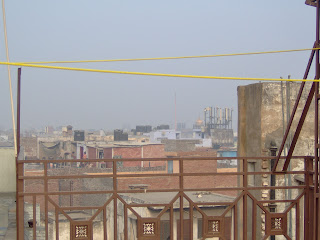A quick narrative:
The capital of Rajasthan was
originally Amber (or Amer) and it was Dhola Rai, the
legitimate heir to the throne in the tenth century was forced to flee
with his mother after being usurped by his uncle. He was adopted by a
Meena (the tribal folk of the region) chieftan and a couple of
generations later, it would be his grandson who would found the
Rajput state of Jaipur, resting Amber away from the Meena tribesmen.
The state, in turn, prospered due to its relations with Akbar the
Great. Always a good man to have in your corner.
 |
| source: http://en.wikipedia.org/wiki/Jai_Singh_I |
It was this man, the Maharaja Jai Singh
whose descendent, Raja Man Singh was appointed chief of the Moghul
armies and won important victories of Akbar. It was he who founded
the Amber Fort.
Raja Man Singh's successor was Bishan Singh who held no rank from Moghul nobility. "He had been serving with Ram Singh in Afghanistan, even though the Mughal Emperor Aurangzeb
had demanded that he be sent to serve in the Deccan Wars. But
remembering the fate of other Hindu princes when serving in the Mughal
armies on distant campaigns, Ram Singh had evaded that order. For this
he had been demoted in rank and reduced in the possession of some
estates—Bishan on the other hand was entirely deprived of his rank and lands" (from Wikipedia, fount of truth). The man was not an idiot. That said, he was not without loyalty to Aurangzeb; however, he refused to participate in the Deccan Wars and in the quashing (attempted) of the Hindu rebellions for which he had scant resources and refused to slaughter civilians. He ended his days in Kabul in the cold of winter in December 1699.
 |
| source: http://www.indianetzone.com/37/maharaja_sawai_jai_singh_ii.htm |
Raja JaiSingh, who inherited the throne at the early (understatement?) age
of eleven (or twelve) when his father Maharaja Bishan Singh had died. I don't
think it's a stretch to characteize Raja Jai Singh as a true
renaissance man: scholar, architect, mathematician, astronomer, he
laid the foundation of a new city which he named after himself:Jaipur.
Raja Jai Singh's road wasn't
necessarily an easy one. After a power struggle in 1707, he had to
win back his rule by uniting the Rajputs against the Moghul ruler of
the time, Bahadur Shah Zafar. It was Bahadur's predecessor who gave
Raja Jai Singh the title of Sawai (one and a quarter) in recognition
of Raja Jai Singh's intelligence. After reconsolidating his power,
the Sawai Jai Singh, founded Jaipur.
The foundation of the city was laid in
1727 and the architectural plans were drawn up based on his vision by
Vidhyadhar Bhattacharya a Bengal architect, who himself had been, if
memory serves, more of an accountant prior to his appointment to this
task. The results, to be seen in some of the photographs, are
stunning.
After his death in 1744, internicine
familial stuggles resulted in leaving a vaccuum for other powers to
come in and reduce the influence of the Singh clan. Perhaps as much
to preserve what influence they could (which was yet substantial),
the Jaipur area found itself slowly aborbed into the British Raj. In
1876, Maharaja Ram Singh painted the entire city pink ( the colour of
welcoming) in honor of the visting Edward, Prince of Wales. Hence,
Jaipur is also known as the Pink City.
Jaipur's last Maharaja was Sawai ManSingh II, who ushered in a new era for Jaipur in the 1930s. He
married the Maharani Gyatri Devi, was an extraordinary polo player
and he established hospitals, schools, and other civic buildings
outside the walls of original city in a push for development and
modernization. After India's independence in 1947, Jaipur was
established as the capital of Rajasthan in 1956.
The royal family still lives in the
City Complex and are well-loved from what I can see, much in the way
the royal family is still for the most part, in England.
One thing that struck me right away on
the way to Jaipur and the surrounding area is the preponderance of
technical schools. The legacy of Sawai Man Singh II's initiatives
seems to continue and I understand that Rajasthan has one of the best
infrastructures in the subcontinent. As I mentioned above, I really
didn't get the same sense of crushing poverty in Jaipur that I saw in
Delhi and I don't think this is mere luck. That said, I also get the
sense that there is a demographic shift as young people move away
from the traditional avenues of an agricultural and artisan based
economy to more contemporary fields of work.
I wish I could speak to conditions in
the wider state of Rajasthan beyond Jaipur. As I say, if I'd had more
time, I'd spend it traveling the region. I don't recall stumbling
into such a wealth of diversity and sheer adventure of learning.






























































